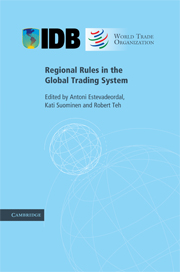Book contents
- Frontmatter
- Contents
- List of figures
- List of tables
- List of Contributors
- Foreword
- Acknowledgements
- List of abbreviations
- 1 Introduction
- 2 Big-Think Regionalism: a critical survey
- 3 Market access provisions in regional trade agreements
- 4 Trade remedy provisions in regional trade agreements
- 5 A mapping of regional rules on technical barriers to trade
- 6 Services liberalization in the new generation of preferential trade agreements: how much further than the GATS?
- 7 Mapping investment provisions in regional trade agreements: towards an international investment regime?
- 8 Competition provisions in regional trade agreements
- Appendix: List of RTAs included in the survey
- Index
7 - Mapping investment provisions in regional trade agreements: towards an international investment regime?
Published online by Cambridge University Press: 01 March 2011
- Frontmatter
- Contents
- List of figures
- List of tables
- List of Contributors
- Foreword
- Acknowledgements
- List of abbreviations
- 1 Introduction
- 2 Big-Think Regionalism: a critical survey
- 3 Market access provisions in regional trade agreements
- 4 Trade remedy provisions in regional trade agreements
- 5 A mapping of regional rules on technical barriers to trade
- 6 Services liberalization in the new generation of preferential trade agreements: how much further than the GATS?
- 7 Mapping investment provisions in regional trade agreements: towards an international investment regime?
- 8 Competition provisions in regional trade agreements
- Appendix: List of RTAs included in the survey
- Index
Summary
Introduction
As stated in the introduction to this volume, regional trade agreements (RTAs) have been essential not simply in connecting countries through increased trade and investment flows but also in terms of shaping and pushing forward the architecture for conducting international trade. This is certainly true in the area of investment, an area in which the multilateral regime is still rather rudimentary, and where incipient international disciplines have rather been forged de facto at the bilateral and regional level.
Although largely absent from the international trade regime after the failure of the 1948 Havana Charter, international foreign direct investment (FDI) emerged as a main topic of interest in international trade arrangements, gaining momentum in the late 1980s with the inclusion of trade-related investment measures in the Uruguay Round negotiations and an investment chapter in the Canada–US Free Trade Agreement (CUSFTA). This interest may be attributed to two main trends. First is the changing domestic attitudes towards international investment, particularly by previously sceptical developing countries that unilaterally opened their economies to trade and investment starting in the 1980s. Investment provisions encapsulated within trade agreements could be seen as signalling their will and ability to ‘lock in’ that liberalization. The second and related trend is the increased role investment has played in the international economy: since the 1980s, flows of investment have grown faster than both trade flows and GDP.
- Type
- Chapter
- Information
- Regional Rules in the Global Trading System , pp. 365 - 417Publisher: Cambridge University PressPrint publication year: 2009
- 6
- Cited by



